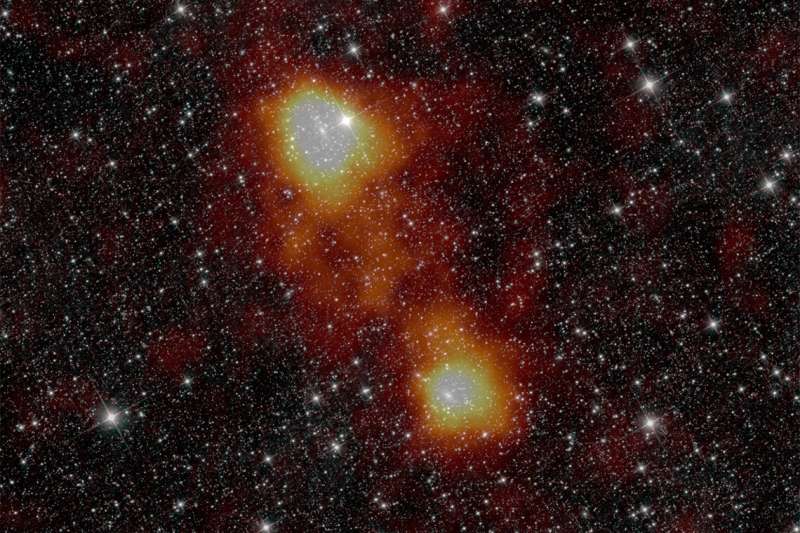Gas measured by ACT+Planck (orange-red) superimposed over two galaxies observed by the Wide-field Infrared Survey Explorer (WISE). A filament of the cosmic web connects them. Credit: WISE data credit (CC-BY-4.0); unWISE/NASA/JPL-Caltech/D. Lang (Perimeter Institute); ACT+Planck map, ACT Collaboration.
Astronomers at the University of Toronto have spotted some of the most elusive stuff in our universe by taking a deep look at the cosmic web, the network of filaments and knots that trace the large-scale distribution of galaxies.
Even though galaxies produce most of the visible light in the universe, they contain fewer than 10 percent of all the atoms in the cosmos. Most of the rest are in the cosmic web in the form of a gas that is so diffuse, there is no more than about one atom per cubic foot of space—far emptier than the best vacuum ever achieved on Earth.
"Because the gas is so thin, it's extremely hard to see," says cosmologist Adam Hincks, an assistant professor cross-appointed to the David A. Dunlap department of astronomy and astrophysics and St. Michael's College. "For years, astronomers referred to this as the 'missing baryon problem.' They expected to see lots of atoms—which we refer to as baryons—but only found a fraction of them when we added up all the glowing matter they could spot."
In recent years, however, astronomers have finally started discovering these elusive atoms.
In Toronto, Hincks—who's also the inaugural holder at St. Michael's of the Sutton Family Chair in Science, Christianity and Cultures—led an international team of scientists that detected the diffuse, hot gas in a roughly 40 million light year-long filament between two clusters of galaxies.
Hincks and his collaborators used archival data from the Planck satellite and more recent data from the Atacama Cosmology Telescope (ACT), in northern Chile, which look at the Cosmic Microwave Background (CMB), the oldest light in the universe.
By observing how the CMB light was scattered by the filament's gas, they determined that the gas in the filament has the mass of about 50 billion suns— about 50 times more mass than our own Milky Way Galaxy.
Although evidence for the filamentary gas in this system had been previously found with the Planck data, the larger ACT instrument sharpened the image considerably, making the distinction between the galaxy clusters and the filament much clearer.
The research is described in a paper published earlier this year in the Monthly Notices of the Royal Astronomical Society. Hincks' co-authors at U of T include Martine Lokken, a Ph.D. student in U of T's astronomy and astrophysics department, and J. Richard Bond, a professor in the Canadian Institute of Theoretical Astrophysics (CITA).
While the research led by Hincks homed in on the missing baryons in a particular set of galaxies, Lokken has been uncovering how this gas is distributed in an ensemble of special regions of the cosmic web.
Lokken, who is supervised by Bond and Renée Hložek, an associate professor in the Dunlap Institute for Astronomy & Astrophysics, used data from the Dark Energy Survey to identify nearly 1,000 galaxy clusters which live in regions of the universe likely to be permeated by filament gas that is denser and hotter than the average.
Lokken then combined their extended gas signal in the Planck and ACT data. She found evidence not only for gas in the clusters themselves but also in filamentary patterns extended away from the clusters. These are expected to contain a great deal of the diffuse gas that was described in the paper by Hincks.
"Our work demonstrates a new way to study gas in the cosmic web," says Lokken. "Accounting for all the so-called 'missing baryons' is one of the most important tasks that we as cosmologists need to tackle. Our directional studies of cosmic gas are a brand new way to probe this problem and other questions about the origins of our universe."
Lokken's work recently appeared in an article in The Astrophysical Journal.
More information: M. Lokken et al, Superclustering with the Atacama Cosmology Telescope and Dark Energy Survey. I. Evidence for Thermal Energy Anisotropy Using Oriented Stacking, The Astrophysical Journal (2022). DOI: 10.3847/1538-4357/ac7043
Adam D Hincks et al, A high-resolution view of the filament of gas between Abell 399 and Abell 401 from the Atacama Cosmology Telescope and MUSTANG-2, Monthly Notices of the Royal Astronomical Society (2021). DOI: 10.1093/mnras/stab3391
Journal information: Monthly Notices of the Royal Astronomical Society , Astrophysical Journal
Provided by University of Toronto
























